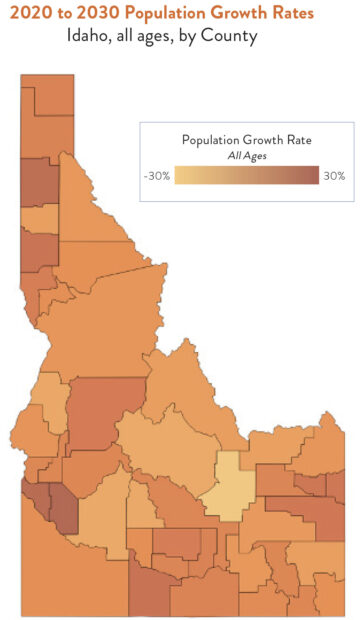Idaho will need around 104 new schools to handle student population growth by 2030, according to a new market analysis commissioned by Idaho charter school support group Bluum.
The analysis, conducted by North Carolina-based research firm Public Impact, offers a heat map of expected student growth by county through the end of the decade.
Ada County topped the list. Here are the top five, with their projected growth rates:
- Ada: 26.1%
- Canyon: 23.6%
- Kootenai: 21.2%
- Twin Falls: 17.1%
- Latah: 16.7%
Most of the expected growth will occur among K-8 students, translating into 39,480 needed seats in those grades from 2020 to 2030, the analysis determined. “At an average elementary school size of 403 students, that means Idaho will need about 98 schools’ worth of (K-8) seats by 2030.”

Idaho’s high school population is expected to grow much slower during that time, swelling by only about 3,000 students, or around “six schools’ worth of seats.”
The study also considered growth opportunities for charters in areas where schools underperform. “Our analysis found 119 schools that were consistently underperforming in 2018-2021 assessment results.” These schools are concentrated in the Boise area and along I-15 in southeastern Idaho.
Idaho today needs 60,500 “high-quality” seats in “new or improved schools to address the chronic underperformance of these schools,” researchers wrote.
Bluum CEO Terry Ryan told EdNews that growth and the need for more schools is a key takeaway. But, he added, other factors, from parent and community demand to the availability of local leadership, impact efforts to meet growth and school improvement needs through charter schools.
“There is no central planning here,” Ryan told EdNews.
Bluum has supercharged the push to grow Idaho charters in recent years through oversight of millions in grants from the J.A. and Kathryn Albertson Family Foundation and Uncle Sam. Idaho has 77 charter schools, which make up just over 9% of the state’s 312,000 public-school students.
Yet demand lingers. Thousands of students were on charter waitlists in 2018.
Meanwhile, Idaho school districts are also planning for growth. The Jefferson and Madison districts last month announced that they’ll put a combined $105.5 million in bond issues for new schools and other upgrades on the March 8 ballot. Bond issues need a two-thirds supermajority of votes to pass.
Though the state provides some funding for charter facilities, charters lack the ability to float bond issues. Charters rely heavily on grants, donations and state funds to build schools.
The analysis uses U.S. Census data and projections from a Nature dataset to make “informed predictions of the future Idaho population.”
Click here for the analysis, which also includes projected growth by demographics in Idaho.
Disclosure: Idaho Education News and Bluum are funded through grants from the J.A. and Kathryn Albertson Family Foundation.
